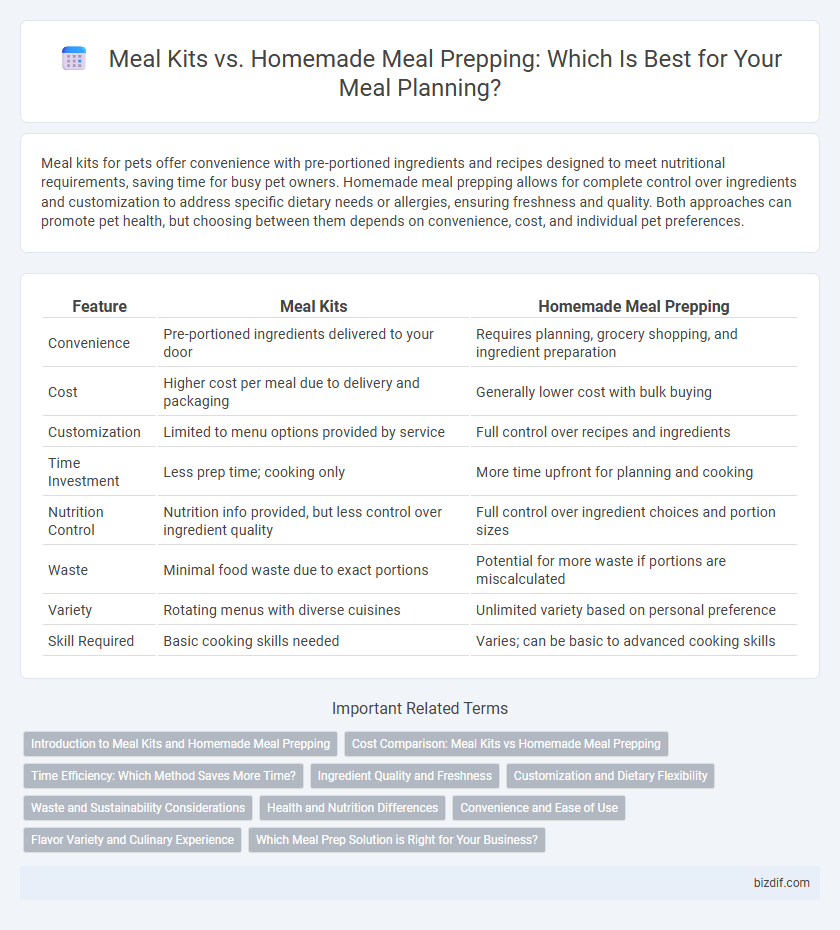Meal kits for pets offer convenience with pre-portioned ingredients and recipes designed to meet nutritional requirements, saving time for busy pet owners. Homemade meal prepping allows for complete control over ingredients and customization to address specific dietary needs or allergies, ensuring freshness and quality. Both approaches can promote pet health, but choosing between them depends on convenience, cost, and individual pet preferences.
Table of Comparison
| Feature | Meal Kits | Homemade Meal Prepping |
|---|---|---|
| Convenience | Pre-portioned ingredients delivered to your door | Requires planning, grocery shopping, and ingredient preparation |
| Cost | Higher cost per meal due to delivery and packaging | Generally lower cost with bulk buying |
| Customization | Limited to menu options provided by service | Full control over recipes and ingredients |
| Time Investment | Less prep time; cooking only | More time upfront for planning and cooking |
| Nutrition Control | Nutrition info provided, but less control over ingredient quality | Full control over ingredient choices and portion sizes |
| Waste | Minimal food waste due to exact portions | Potential for more waste if portions are miscalculated |
| Variety | Rotating menus with diverse cuisines | Unlimited variety based on personal preference |
| Skill Required | Basic cooking skills needed | Varies; can be basic to advanced cooking skills |
Introduction to Meal Kits and Homemade Meal Prepping
Meal kits provide pre-portioned ingredients and step-by-step recipes designed to simplify cooking while minimizing food waste and preparation time. Homemade meal prepping involves selecting ingredients, cooking meals in advance, and storing portions to customize nutrition and control ingredient quality. Both approaches offer convenience and time-saving benefits but differ in flexibility, cost, and level of culinary involvement.
Cost Comparison: Meal Kits vs Homemade Meal Prepping
Meal kits typically cost between $8 to $12 per serving, whereas homemade meal prepping can reduce costs to as low as $3 to $5 per serving by purchasing ingredients in bulk. The premium pricing of meal kits covers convenience, pre-measured ingredients, and recipe development, which can outweigh the lower ingredient expense of homemade meal prepping. Bulk buying strategies and strategic meal planning enable homemade meal prepping to offer substantial savings, making it a more cost-effective option for budget-conscious individuals.
Time Efficiency: Which Method Saves More Time?
Meal kits minimize grocery shopping and meal planning time by providing pre-portioned ingredients and detailed recipes, often allowing meals to be prepared in 20 to 30 minutes. Homemade meal prepping can save more time during the week through batch cooking but requires upfront investment for grocery shopping and ingredient preparation, typically taking 1 to 2 hours initially. Consumers seeking immediate weeknight convenience may prefer meal kits, while those prioritizing long-term time savings often favor homemade meal prepping.
Ingredient Quality and Freshness
Meal kits often provide pre-portioned ingredients sourced from suppliers prioritizing convenience rather than peak freshness, which can affect flavor and nutritional value. Homemade meal prepping allows for direct selection of fresh, high-quality ingredients from local markets or organic producers, ensuring better control over ingredient freshness and overall meal quality. Consistently using fresh produce, high-grade proteins, and minimally processed components in homemade meal prepping can significantly enhance taste and health benefits compared to typical meal kit options.
Customization and Dietary Flexibility
Meal kits offer convenience but often limit customization due to preset ingredients and portion sizes, which may not suit specific dietary needs or preferences. Homemade meal prepping provides greater dietary flexibility by allowing complete control over ingredient choices, meal portions, and nutritional content tailored to individual health goals. Personalized meal planning enhances adherence to dietary restrictions such as gluten-free, keto, or vegan diets, making homemade prepping a better option for customized nutrition.
Waste and Sustainability Considerations
Meal kits often generate excess packaging waste due to individually wrapped ingredients, while homemade meal prepping allows for more efficient use of bulk ingredients, reducing overall waste. Homemade meal prepping offers greater control over portion sizes and ingredient sourcing, supporting sustainability through local and seasonal produce. Choosing homemade meal prepping over meal kits can significantly lower the environmental footprint by minimizing plastic waste and food spoilage.
Health and Nutrition Differences
Meal kits offer portion-controlled ingredients and nutritional information, which can help manage calorie intake and ensure balanced meals; however, they often contain preservatives and higher sodium levels compared to homemade meal prepping. Homemade meal prepping allows full control over ingredient quality, portion sizes, and cooking methods, enabling tailored nutritional benefits such as reduced sodium, fresher produce, and customizable macronutrient profiles. Choosing homemade options supports antioxidant-rich meals and limits processed additives, promoting better overall health and dietary adherence.
Convenience and Ease of Use
Meal kits offer convenience by providing pre-portioned ingredients and step-by-step instructions that simplify the cooking process, reducing preparation time and minimizing decision fatigue. Homemade meal prepping requires more initial effort in planning and ingredient sourcing but allows greater control over portion sizes, dietary preferences, and ingredient quality. Choosing between meal kits and homemade meal prepping depends on balancing time savings with customization needs to fit individual lifestyles effectively.
Flavor Variety and Culinary Experience
Meal kits offer a diverse range of flavors curated by professional chefs, providing convenience and ingredient variety without the need for extensive culinary skills. Homemade meal prepping enables full control over ingredient selection and seasoning, fostering creativity and the ability to tailor dishes to personal taste preferences. Both methods enhance flavor variety, but home cooking delivers a richer culinary experience through hands-on technique and customization.
Which Meal Prep Solution is Right for Your Business?
Meal kits offer scalable, consistent portioning and ingredient sourcing, ideal for businesses seeking efficiency and standardized quality. Homemade meal prepping provides flexibility in customizing recipes and adapting menus to niche customer preferences, benefiting brands focusing on unique culinary experiences. Evaluating operational capacity, cost structures, and target market demands helps determine the most suitable meal prep solution for a business.
Meal Kits vs Homemade Meal Prepping Infographic

 bizdif.com
bizdif.com